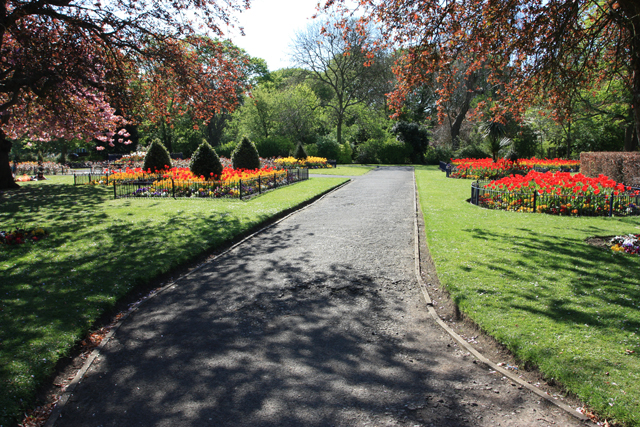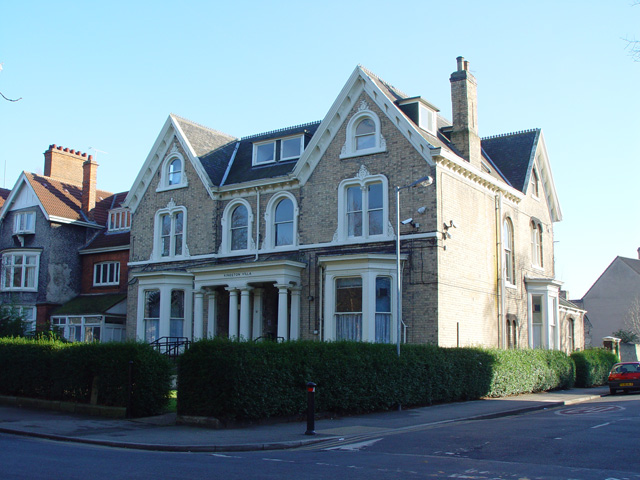Pearson Park on:
[Wikipedia]
[Google]
[Amazon]
Pearson Park, originally known as the People's Park is a park in the west of
 During the
During the  Housing development on the surrounding road took place throughout the latter part of the 19th century; by 1890 much the road had been developed, all substantial houses; F. W. Hagen was architect for many of them, numbers 43, 50 and 54, all from the early 1860s are listed buildings.
During the construction of the Hull and Barnsley Railway in the 1880s, the navies were housed in huts built in the park.
A memorial to Pearson was added in 1897, as a marble relief, fixed to an
Housing development on the surrounding road took place throughout the latter part of the 19th century; by 1890 much the road had been developed, all substantial houses; F. W. Hagen was architect for many of them, numbers 43, 50 and 54, all from the early 1860s are listed buildings.
During the construction of the Hull and Barnsley Railway in the 1880s, the navies were housed in huts built in the park.
A memorial to Pearson was added in 1897, as a marble relief, fixed to an
Kingston upon Hull
Kingston upon Hull, usually abbreviated to Hull, is a port city and unitary authority in the East Riding of Yorkshire, England.
It lies upon the River Hull at its confluence with the Humber Estuary, inland from the North Sea and south- ...
, England
England is a country that is part of the United Kingdom. It shares land borders with Wales to its west and Scotland to its north. The Irish Sea lies northwest and the Celtic Sea to the southwest. It is separated from continental Europe ...
. It is situated about north-west of the city centre of Hull with its main entrance on Beverley Road
Beverley Road (known in local parlance as Bev Road) is one of several major roads that run out of the city of Hull in the East Riding of Yorkshire, England. The road is noted for being a major arterial route into, and out of Hull. It also known ...
and its western boundary adjoining Princes Avenue.
The park was established in 1862 through the gift of land by Zachariah Pearson, and was the first public park in the city.
History
 During the
During the Victorian period
In the history of the United Kingdom and the British Empire, the Victorian era was the period of Queen Victoria's reign, from 20 June 1837 until her death on 22 January 1901. The era followed the Georgian period and preceded the Edward ...
the lack of or need for public spaces for working classes to exercise, or otherwise enjoy themselves became a public cause; in 1833 a parliamentary select committee Select committee may refer to:
*Select committee (parliamentary system) A select committee is a committee made up of a small number of parliamentary members appointed to deal with particular areas or issues originating in the Westminster system o ...
on Public Walks published a paper which promoted the need for open green spaces in cities. An early proposal in Hull was for a walk around the town from Humber bank to Humber bank; this re-appeared as the ''Grand Victoria Promenade Company'' in 1845, which proposed a wide road and tree lined walk; the scheme did not go ahead, and the Victoria Dock Branch Line () was built along a similar route. In the late 1850s an attempt was made to gain the rights to the use of the land of the former Hull Citadel for use as a public space, leading to an unsuccessful suit in the Court of Chancery
The Court of Chancery was a court of equity in England and Wales that followed a set of loose rules to avoid a slow pace of change and possible harshness (or "inequity") of the common law. The Chancery had jurisdiction over all matters of equ ...
in 1861 made by the Corporation of Hull against the Government.
In 1860 the then Mayor, Zachariah Pearson, donated a plot to the board of health on the proviso it would be developed as a park. He retained on three sides of the park, and constructed a road to the land. At this time the land lay outside the urban growth of the town, close to the hamlet of Stepney
Stepney is a district in the East End of London in the London Borough of Tower Hamlets. The district is no longer officially defined, and is usually used to refer to a relatively small area. However, for much of its history the place name appli ...
.
On 28 August 1860 the park was inaugurated. The event was organised by Enderby Jackson
John Enderby Jackson (14 January 1827 – 10 April 1903) was an English musician, composer, and the self-described founder of the British brass band competition and the cheap day railway excursion.
After training in the family business of candl ...
; a procession starting at Mansion House to the park took place, the whole train over 2 miles long. According to around 30,000 visitors came to Hull by railway to observe the proceedings. A ceremony involving the deed of conveyance took place, and the Mayor, Zachariah Pearson then planted a tree, a Wellingtonia Gigantea. Celebrations were continued at the Station Hotel, with a dinner and fireworks display, and to the next day, with further ceremonial tree planting.
At the opening ceremony Pearson noted the intention of providing open spaces for the good health of the working population, also noting that the aim of constructing high status houses around the park was to keep the wealthy citizens of Hull living within Hull.
The original park design was by J. C. Niven; in 1864 the park included a cricket ground, a folly ''The Ruins'', statues of Queen Victoria
Victoria (Alexandrina Victoria; 24 May 1819 – 22 January 1901) was Queen of the United Kingdom of Great Britain and Ireland from 20 June 1837 until her death in 1901. Her reign of 63 years and 216 days was longer than that of any previ ...
and of Ceres, the goddess, as well as a lake. Other areas were set aside for a bowling green, archery, and gymnastics. In addition a road had been built around the park, along which high quality 'villa' residences were under construction. The main entrance, from Beverley Road, wide by high, was an ornamental gateway by Young and Pool, iron gates by Thompson and Stather of Hull formed the Princess Avenue entrance. The east entrance lodge, (1861?) is now listed.
Other early features surviving included a cast iron drinking fountain (1861), and statues of Queen Victoria (installed 1861) and Prince Albert (installed 1868), both by Thomas Earle.
 Housing development on the surrounding road took place throughout the latter part of the 19th century; by 1890 much the road had been developed, all substantial houses; F. W. Hagen was architect for many of them, numbers 43, 50 and 54, all from the early 1860s are listed buildings.
During the construction of the Hull and Barnsley Railway in the 1880s, the navies were housed in huts built in the park.
A memorial to Pearson was added in 1897, as a marble relief, fixed to an
Housing development on the surrounding road took place throughout the latter part of the 19th century; by 1890 much the road had been developed, all substantial houses; F. W. Hagen was architect for many of them, numbers 43, 50 and 54, all from the early 1860s are listed buildings.
During the construction of the Hull and Barnsley Railway in the 1880s, the navies were housed in huts built in the park.
A memorial to Pearson was added in 1897, as a marble relief, fixed to an ironstone
Ironstone is a sedimentary rock, either deposited directly as a ferruginous sediment or created by chemical replacement, that contains a substantial proportion of an iron ore compound from which iron (Fe) can be smelted commercially. Not to be con ...
monolith.
A bandstand was installed in 1908. In 1912 a cupola
In architecture, a cupola () is a relatively small, most often dome-like, tall structure on top of a building. Often used to provide a lookout or to admit light and air, it usually crowns a larger roof or dome.
The word derives, via Italian, f ...
rescued from Cuthbert Brodrick's Hull town hall was installed in the park. In around 1930 a Victorian style conservatory was built near the lake.
During the Second World War
World War II or the Second World War, often abbreviated as WWII or WW2, was a world war that lasted from 1939 to 1945. It involved the vast majority of the world's countries—including all of the great powers—forming two opposi ...
the park housed nissen hut
A Nissen hut is a prefabricated steel structure for military use, especially as barracks, made from a half-cylindrical skin of Corrugated galvanised iron, corrugated iron. Designed during the First World War by the American-born, Canadian-British ...
s and air raid shelters, which were removed in 1954; part of the park's serpentine path system was lost during these modifications. An iron bridge across the lake, and the bandstand were also removed after the Second World War.
Late 20th century modifications include installation of fountains in the lake, construction of a children's playground on the west edge of the park (replacing tennis courts, and originally a bowling green). The 150th anniversary of the park opening was celebrated on 29 August 2010, as part of the celebrations another '' Wellingtonia gigantea'' tree was planted.
In summer 2017 £3 million was awarded by the Heritage Lottery Fund
The National Lottery Heritage Fund, formerly the Heritage Lottery Fund (HLF), distributes a share of National Lottery funding, supporting a wide range of heritage projects across the United Kingdom.
History
The fund's predecessor bodies were ...
for restoration work on the park. Work got underway in December 2018 with the dismantling of the entrance archway. Restoration of the archway took a year and was officially reopened on 19 December 2019.
See also
* ''High Windows'', poem by poetPhilip Larkin
Philip Arthur Larkin (9 August 1922 – 2 December 1985) was an English poet, novelist, and librarian. His first book of poetry, ''The North Ship'', was published in 1945, followed by two novels, ''Jill'' (1946) and ''A Girl in Winter'' (1947 ...
, based on the view from No.32 Pearson Park, his home for 18 years from 1956.
Notes
References
Sources
* * * *External links
* *{{cite web, url = http://www.paul-gibson.com/history/fountains.php, title = A short history of Hull's fountains, first = Paul, last = Gibson, access-date = 15 November 2013, archive-url = https://web.archive.org/web/20100810194251/http://www.paul-gibson.com/history/fountains.php, archive-date = 10 August 2010, url-status = dead Includes Pearson Park fountains. Parks and open spaces in Kingston upon Hull 1862 establishments in England Geographic histories of Kingston upon Hull